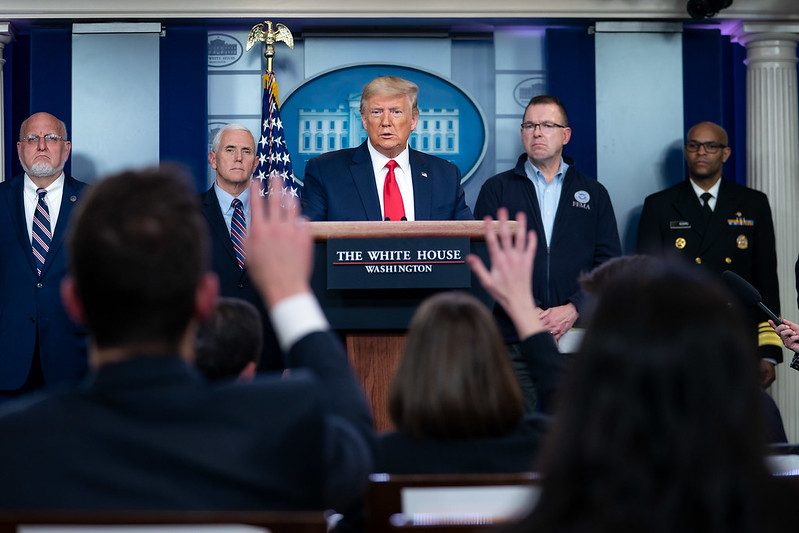How Are American Views of the Coronavirus Crisis Evolving as It Intensifies?
Findings from a poll of 2,395 American adults, over a nine-day period.

Published by The Lawfare Institute
in Cooperation With

How are American views of the threat of the coronavirus and the Trump administration’s handling of the crisis evolving as it intensifies? To find out, we conducted a University of Maryland Critical Issues Poll over a nine-day period, March 12-20, among a nationally representative sample of 2,395 Americans adults, with date stamps allowing us to measure change in attitude over that period. Here is what we found.
A plurality of respondents said they are unsatisfied with the Trump administration’s handling of the coronavirus (47 percent) while 42 percent said they are satisfied, and 10 percent said they are neither satisfied nor unsatisfied. As expected, there is a huge partisan divide, with 81 percent of Democrats saying they are unsatisfied, and 79 percent of Republicans saying they are satisfied. A slight majority of independents (51 percent) say they are dissatisfied, and 29 percent satisfied, with the Trump administration’s handling.

However, over the nine-day period, there was a small but measurable change in attitudes. The number of those unsatisfied with the administration’s handling of the coronavirus dropped from 49 percent in the first three days to 45 percent in the final three days. This appeared to hold across the partisan divide, with Republicans going from 14 percent unsatisfied to 5 percent; Democrats from 86 percent to 79 percent; and independents from 57 percent to 47 percent.

Despite this slight improvement in the perception of the administration’s handling of the crisis, trust in Trump’s truthfulness when he speaks has remained particularly low and even worsened during the same period. Overall, 45 percent of Americans say that Trump never tells the truth while 20 percent say he tells the truth “some of the time,” 24 percent believe he tells the truth “most of the time,” and only 10 percent say he tells the truth “all of the time.” More people said the president never tells the truth in the last three days (46 percent) than in the first three days (42 percent). For comparison, 22 percent said that Joe Biden never tells the truth and 19 percent said the same for Bernie Sanders, and these numbers remained roughly constant for the period.

Over the nine-day period, the poll also measured a gradual increase in the number of Americans worried about the threat that the coronavirus poses to them personally and to the United States generally. Overall, Americans are even more worried about the threat the virus poses to the U.S. than it poses to them personally, even as they are worried about both. Overall, 56 percent are either somewhat worried or worried a great deal about the threat that the virus poses to them personally, and 77 percent are worried about the threat that it poses to the U.S. as a whole. Notably, over the nine-day period, these worries have increased for both categories. Those who said they are worried about personal threat went from 51 percent to 62 percent, and those worried about the threat to the U.S. went from 73 percent to 82 percent.


As other polls have found, Republicans are less worried about both threats: 44 percent said they are worried about the threat to them personally, compared with 68 percent of Democrats, and 53 percent of independents; and 68 percent of Republicans are worried about the threat to the U.S., compared with 86 percent of Democrats.
However, as with the rest of the population, the number of Republicans worried about the threat to themselves and to the U.S. increased over the nine-day period, going from 38 percent to 49 percent, and 62 percent to 74 percent, respectively.
These trends show that, as the crisis persists, more Americans are worried, but also slightly more Americans are satisfied with the administration’s handling of the crisis, transcending the partisan divide. At the same time, the lack of trust in President Trump has remained high, even increased. How does one explain the increase in American satisfaction—even if most Americans remain unsatisfied?
There are likely two principal reasons. First, the administration did move to announce some dramatic actions during this period—on March 13, Trump declared a national emergency; on March 14, the administration said that it would ban travel from the United Kingdom and Ireland; on March 16, the White House issued guidelines to Americans urging them to avoid bars and restaurants, to limit gatherings to 10 or fewer people, and to work from home and engage in homeschooling; and on March 18, the administration closed the U.S.-Canada border to nonessential traffic.
Second, as the crisis intensified, and Americans measurably became more worried—the president even called himself a “wartime president”—one might expect some rallying around the flag, even in a polarized time. In fact, the surprise here is not that there is some effect but that the effect seems relatively small in comparison to other crises: President George W. Bush, who had a contentious election in 2000, had an approval rating as low as 51 percent divided along partisan lines before the 9/11 attack; immediately after, his approval rating spiked to 90 percent.
Still, the full scale of the coronavirus crisis remains unknown, and, after announcing dramatic steps during the nine-day period of our poll, the president recently signaled he may soon change course. There is nothing we see in the poll to suggest that Americans will come together behind Trump’s handling of the crisis.
The survey was carried out March 12-20, 2020, online from a nationally representative sample of Nielsen Scarborough’s probability-based panel, originally recruited by mail and telephone using a random sample of adults provided by Survey Sampling International. The poll was conducted among a national poll of 2,395 respondents, with a margin of error of +/- 2 percent. Overall, the sample was adjusted to reflect population estimates (Scarborough USA+/Gallup) for Americans. The survey variables balanced through weighting were age, gender, race/ethnicity, household income, level of education, census regional division and political party affiliation.


.jpg?sfvrsn=e915b36f_5)


